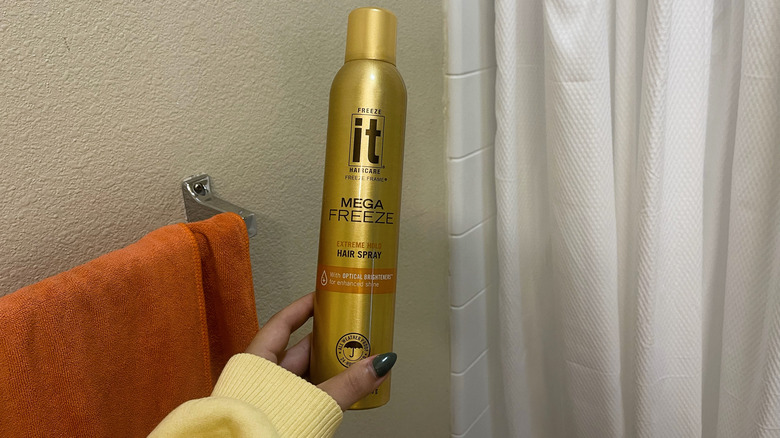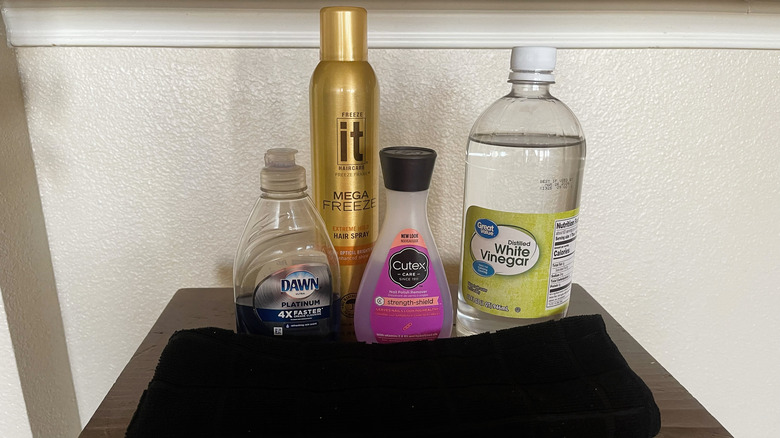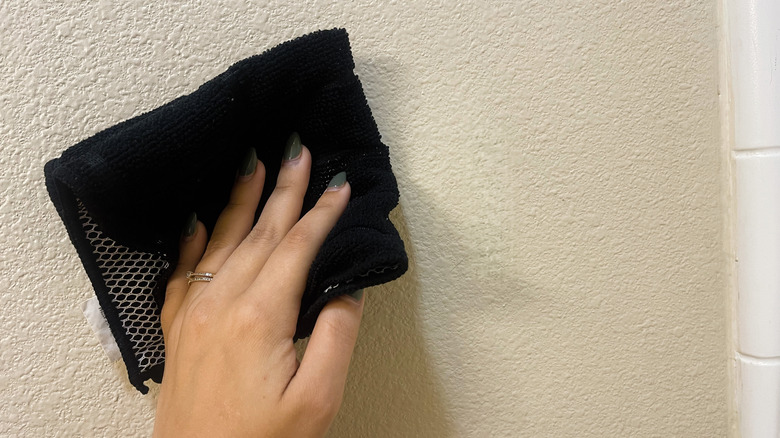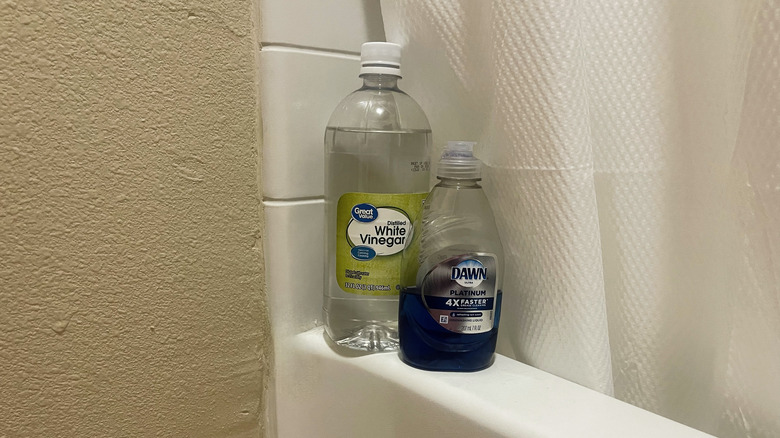We Tried 3 Methods To Clean Hairspray Off Our Bathroom Walls And We Weren't Too Impressed
If strong winds or high humidity has ever ruined the curls that took you hours to perfect or caused flyaways to slip from your manicured updo, you know that hairspray is a lifesaver. However, as you also know, trying to apply hairspray without it also coating your bathroom counters, sinks, and walls is nearly impossible. Cleaning hairspray off of surrounding surfaces can be tricky, as this product contains polymers that act like glue to hold hair in place for long periods of time. Since hairspray is meant to combat high humidity and heat among other environments, it can't be cleaned off of walls with just water. You also shouldn't let sticky hairspray residue build up on any surfaces in your home, as the longer it sits, the harder it will be to wipe away and the more risk it has of leaving visible stains.
Because hairspray is so difficult to remove from bathroom walls, we experimented with three different solutions to find a cleaning method that worked best. We tried white vinegar, mild dish soap, and nail polish remover. While we experienced varying results between the three different remedies, we were able to conclude which outcomes were the most successful.
Here's what we used
To test different ways to remove hairspray residue from our bathroom walls effectively, we went to our local Walmart and bought a bottle of Great Value Distilled White Vinegar for under $2, Cutex Nail Polish Remover for $2, and Freeze It Hairspray for about $8. To ensure we were testing an intense and persistent product, we chose an extreme hold hairspray that has 24-hour holding capabilities. We thought that these products would work for cleaning off hairspray because white vinegar is a common household cleaner that helps break down dirt, oils, and other bacteria, and the high concentration of acetone in nail polish remover is an excellent dissolvent.
Along with white vinegar and nail polish remover, we used Dawn Liquid Dish Soap that we already had at home but that could be purchased for under $5. Finally, we used microfiber cloths, as these work well for cleaning due to their gentle texture. We hoped that using towels in this soft material would help avoid accidentally removing paint from the walls when scrubbing off the hairspray. If you don't already own microfiber towels, Walmart sells Great Value Microfiber Cleaning Towels in packs of two for less than $2. It was our goal to try cleaning remedies with materials that are typically already sitting at home in your cupboards or that can be bought for a very low cost.
Scrubbing away the hairspray
Once all the necessary supplies were gathered, we put each solution to the test by spraying three patches of hairspray onto our bathroom wall and cleaning each area with a different product. First, we tested our nail polish remover. Pouring it directly from the bottle onto our microfiber cloth, we gently began washing the hairspray off the wall. However, even with the gentlest hand, we found that a lot of the wall paint was removed along with the hairspray.
Next, we tested the white vinegar by mixing ½ a cup of water with 1 cup of vinegar. Dipping our soft towel into the solution, we cleaned the second patch of hairspray from the wall with little to no paint removal. Lastly, we added five drops of our mild detergent into ½ a cup of water and applied it to our towel to clean the last patch of hairspray off our walls. Although this method took longer than the previous two, there was even less of a problem with removing paint, and it left behind a clean and pleasant smell.
Which method works best?
After testing out the nail polish remover, white vinegar, and mild soap cleaning solutions, we concluded that nail polish remover should not be used when cleaning hairspray off your painted walls. While we found it effective in removing the hairspray, it also removed layers of paint and left clear markings and discoloration. Nail polish remover will be better for your mirrors or countertops that need hairspray residue removed.
Of the three, the dish soap caused the least damage to our wall but took 10 minutes of consistent scrubbing to remove the patch of hairspray. By the end, our hands and arms were quite tired. Further, it would've taken much longer if the product had spread outside of our controlled area, which would likely be the case with consistent use. White vinegar was the quickest method and took us half the time the soap did. The vinegar removed a little more paint than we saw with the dish soap, but it was still meager and unnoticeable. Over time, though, it could make a visible difference if you're consistently cleaning in the same area. For anyone who frequently uses hairspray and finds cleaning its overspray a weekly occurrence, we'd suggest using mild dish soap to avoid as much paint deterioration as possible. But, for those who only use the product occasionally, white vinegar will be a quick and efficient remedy for any remnants that splatter onto your bathroom walls.



